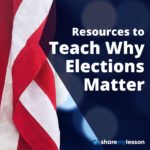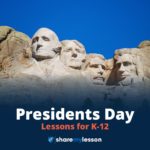The purpose of this lesson is to have students learn about each presidential election and presidential terms. Students will understand how various events in history shaped campaigns. Why elections were won and lost. What accomplishments and disappointments each president experienced. Each election and presidential term served had its own mark on history. The presentation to the class is the order of the elections starting with Washington’s first election and proceeding forward. The lesson plan was created to engage students in the election process and create interest in the coming presidential election.
Constituting America’s 90 Day Study of The Intrigue of Presidential Elections and Their Constitutional Impact is a resource guide for students. This study supplies many of the important facts and figures of each presidential campaign. There are also intriguing facts, stories, and information about the person, campaign, time in office and after the presidency.
Civic Education and Election Resources

It’s election season in the United States and a good time for students to understand why local and national politics matter and the core principles on how our democracy and elections works. What is gerrymandering? How can we strengthen our democracy? Plan how to answer questions like these as Election Day draws closer. Use these free K-12 civic education lessons, activities, blogs and webinars to help you educate students on the election and the importance of counting every vote. Additional topics include fostering civil discourse, fighting fake news, voting rights and debate ideas to keep your students informed and engaged.
The Electoral College
Today, the American people vote for president and vice president on Election Day. But, technically speaking, these votes don’t directly determine the outcome of the election. These popular votes determine which electors will be appointed to the Electoral College, which is made up of 538 electors drawn from the states and the District of Columbia. Each state is granted a different number of electoral votes based on the size of its congressional delegation. The electors meet after the general election to cast their votes for president and vice president.
The Electoral College Process
In this activity, students will learn the steps in the Electoral College process, from Election Day to Inauguration Day. They will analyze historical primary sources from various Presidential elections, each representing a different step in the process, and arrange them in the correct sequence.
Election: The Road to the White House (Secondary)
During an election, civic energy reaches a fever pitch. The vote is one of the citizen’s most powerful tools, and advocating for a candidate, a set of ideas, or a platform is the right of every citizen. The President of the United States is often called the most powerful person in the world, so with every presidential election, the stakes are high. This unit is designed to teach students about presidential elections. It is not a collection of facts, diagrams, and explanations of processes. It is an interactive, project-based unit that invites the student to fully engage in the process of an election while also informing students about how elections work. It is our hope that this unit helps cultivate the sorts of informed and engaged citizens that are so essential to our democracy.
The Constitution in Action – Political Parties and Presidential Electors: The Election of 1800
History is the chronicle of choices made by actors/agents/protagonists in specific contexts. This simulation places students in the Early Republic and asks them to engage in the politics of those times. Acting as either Federalists or Republicans, they will be asked to develop strategies for electing their party’s standard bearer as president, using the Constitution’s complex system of presidential electors to their advantage.
Should the Federal Government Regulate States’ Election Procedures?
Students will be able to identify and explain aspects of the election regulation debate, including its potential impact on voter turnout, election transparency, and voting equity.
Constitution Day Word Search
Here’s a fun activity for all ages with vocabulary that is tied to Constitution Day! Answers are provided as well!
Presidents Day Lesson Plans & Resources

Presidents Day was originally established in 1885 as “Washington’s Birthday” to celebrate President George Washington’s birthday on February 22. In 1971, the federal government renamed the holiday Presidents Day in order to honor all U.S. presidents, past and present. Share My Lesson has curated a collection of free lesson plans, educational resources and classroom materials on the accomplishments of U.S. presidents, first ladies, and the role and responsibilities of the president in government and in a democracy.
Choosing to Make a Nation: Constitutional Convention Simulation
The Choosing to Make a Nation Curriculum Project developed by award-winning author Ray Raphael is a student-centered, primary source-rich approach to teaching about American history and our nation‘s founding documents.
An 8-lesson simulation in which students become delegates from specific states and address the same issues the framers faced. Unit includes the following lesson plans –
(1) Reform or Revolution?
(2) Composition of Congress
(3) Creating an Executive Branch
(4) Should Judges Judge Laws?
(5) Balance of Powers
(6) Slavery and the Constitution
(7) Amendments and Ratification
(8) To Sign or Not to Sign?
Option A: The historical Constitution
Option B: Student-generated constitution